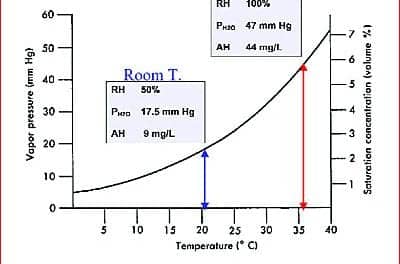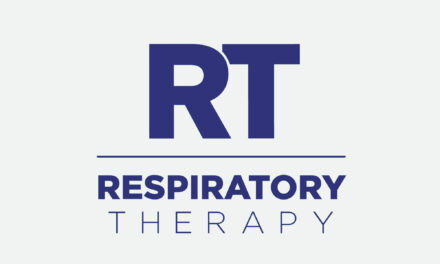Reviewing all the steps needed to accurately assess a patient’s oxygenation status can prevent oversimplifications and mistakes.
Evaluation of oxygenation is often oversimplified. Health care providers frequently rely on Po2, pulse-oximetry saturation (Spo2), or calculated oxygen saturation (%r assessing oxygenation status. Although these determinations yield valuable information, they do not present a complete picture. For example, a patient with moderate to severe carbon monoxide poisoning and significant oxygen deprivation at the tissue level may have normal Po2, Spo2, and calculated oxygen saturation values. Other conditions and situations also cause Po2, Spo2, and calculated oxygen saturation assessments to be inadequate and potentially misleading. For this reason, the evaluation of a patient’s oxygenation status should not be limited to these parameters.
TISSUE OXYGENATION
The five key components of oxygenation are perfusion, oxygen-hemoglobin (o2hb) dissociation, tissue oxygen affinity, Po2, and oxygen content.1
Perfusion is the circulation of blood through tissues. For adequate tissue oxygenation to occur, well-oxygenated blood must be circulated at a sufficient flow to meet the patient’s metabolic needs. Numerous factors affect perfusion, including heart rate, stroke volume, blood pressure, capillary resistance, and shunts. Further, adequate oxygen-carrying hemoglobin must be present under conditions (and in a state) that allow oxygen dissociation. The tissues must also be able to accept the released oxygen.
Tissue oxygen affinity is the ability of the tissues to accept oxygen. Usually, oxygen affinity at the tissue level is not an issue. Cyanide, carbon monoxide, and alcohol poisoning, however, can interfere with the ability of tissues to accept oxygen.
The Po2, as measured by blood gas analyzers, is the partial pressure exerted by oxygen dissolved in the blood plasma and is expressed in mm Hg. By virtue of the sizable oxygen pressure gradient, oxygen moves from plasma to tissues. The pressure gradient is substantial, as Pao2 is usually greater than 90 mm Hg and tissue Po2 is usually 5 to 10 mm Hg. As blood moves through the tissues, oxygen is extracted from the plasma. The volume of oxygen dissolved in the plasma is minimal when compared to the volume carried as oxyhemoglobin. For every mm Hg of Po2, only 0.00314 mL of oxygen will be dissolved in plasma. A Po2 of 100 mm Hg is equivalent to 0.3 mL of oxygen dissolved in 100 mL plasma at 37 degrees C.
Oxygen content is the total amount of oxygen carried in the blood and is expressed as milliliters of oxygen per deciliter of blood. Oxygen content is the sum of oxyhemoglobin and the very small amount of oxygen (0.3 mL) dissolved in 100 mL plasma.
Each gram of fully saturated (100 percent) oxyhemoglobin is capable of carrying 1.39 mL oxygen (although, in reality, hemoglobin is rarely 100 percent saturated). Total hemoglobin and the percentage of oxyhemoglobin are measured by co-oximeters, which first calculate the oxygen content of hemoglobin according to the following formula: total hemoglobin (in grams per deciliter) multiplied by 1.39 mL/g hemoglobin multiplied by the percentage of oxyhemoglobin. A patient with a total hemoglobin of 15 g/dL and 97 percent oxyhemoglobin will have 20.2 mL oxygen per 100 mL plasma (15 g/dL x 1.39 mL/g x 0.97=20.2 mL O2/dL. Then, to determine the total oxygen content, the amount of oxygen dissolved in plasma must be added to the oxygen content of oxyhemoglobin (20.2 mL O2/dL 0.3 mL O2/dL). The amount of oxygen carried as dissolved O2 (calculated from the Po2 level) represents only about 1.5 percent of total oxygen; therefore, using this measure to assess oxygen status may be deceptive. For example, a patient with anemia can have a normal Po2, yet be oxygen deprived due to the absence of adequate hemoglobin.
Tissue oxygenation also is affected by the ability of hemoglobin to release oxygen as needed. As oxyhemoglobin passes through capillary beds, it is exposed to a tissue microenvironment that accelerates the release of oxygen (its dissociation from hemoglobin). Oxygen dissociates from adult hemoglobin in a characteristic fashion. Metabolizing tissues facilitate oxygen release due to increased levels of carbon dioxide and 2,3-Diphosphoglycerate (2,3-DPG), increased temperature, and decreased pH. Hemoglobin releases oxygen in response to demand. The higher the rate of tissue metabolism, the more oxygen is released. Conversely, when hemoglobin passes through the lungs, it picks up oxygen (through oxygen association).
Under normal conditions, oxyhemoglobin association and dissociation work well. Dyshemoglobins, however, interfere with the ability of hemoglobin to bind and release oxygen. Dyshemoglobins are formed when hemoglobin is exposed to a variety of substances. The most common dyshemoglobins are carboxyhemoglobin and methemoglobin. The presence of carboxyhemoglobin and/or methemoglobin reduces the amount of hemoglobin available to combine with oxygen, thus causing a chemical anemia. Carboxyhemoglobin is formed due to carbon monoxide exposure. Smoke inhalation, faulty automobile exhaust, and home heating systems are common sources of carbon monoxide exposure. Chemical exposure to compounds such as methylene chloride, a common home and industrial solvent, can also cause carboxyhemoglobinemia.2
Methemoglobin forms when the iron in the hemoglobin oxidizes from the Fe 2 (ferrous iron) to Fe 3 (ferric) state. Methemoglobinemia can be congenital but more commonly occurs from exposure to a variety of chemical and bacterial agents, including amyl nitrite, benzocaine, chlorates, lidocaine, nitrites, phenacetin, phenols, and toluidene.3 Dyshemoglobins also alter the oxyhemoglobin dissociation curve and reduce the amount of oxygen released at the tissues. Carboxyhemoglobin further interferes with tissue oxygen release by poisoning myoglobin (a form of hemoglobin in muscle tissue). When dyshemoglobins are present, only the measured Po2 and oxyhemoglobin will be correct. Spo2 and calculated oxygen saturation values are not reliable in that they will overestimate the saturation of hemoglobin with oxygen.
ASSESSMENT PARAMETERS
The four parameters commonly used to assess a patient’s oxygen status are calculated oxygen saturation, oxyhemoglobin, Spo2, and Po2.
Measured oxygen saturation represents the ratio of oxygen that is bound to the carrier protein-hemoglobin-compared with the total amount of hemoglobin that could bind oxygen. Blood gas instruments calculate oxygen saturation ( o2) based on the patient’s Po2 and total hemoglobin. These calculated results can differ significantly from those determined by direct measurement of oxyhemoglobin due to algorithms in the blood gas instruments that assume a specific shape for the oxyhemoglobin dissociation curve and due to the presence of other dyshemoglobins incapable of binding oxygen. Because of the potential for generating erroneous information, standard C-25A of the National Committee for Clinical Laboratory Standards recommends that calculated oxygen saturation values not be used to assess a patient’s oxygenation status.4
The oxyhemoglobin percentage is the ratio of the concentration of oxyhemoglobin to the concentration of total hemoglobin, which includes all forms of hemoglobin. Oxyhemoglobin levels are determined spectrophotometrically using a co-oximeter, an instrument designed to measure the various hemoglobin species directly. Each species of hemoglobin has a characteristic absorbance curve. When dyshemoglobins are not included in the total hemoglobin, there will be an overestimation of oxygenation.
Calculated oxygen saturation and oxyhemoglobin cause further confusion because, in most healthy individuals (and even with some disease states), their numerical values can be very similar. The values for oxyhemoglobin and calculated oxygen saturation deviate in several conditions. For example, smokers typically have lower oxyhemoglobin values due to the preferential binding of carbon dioxide to hemoglobin, forming carboxyhemoglobin and resulting in a loss of hemoglobin to bind oxygen.
Spo2 is an in vivo, noninvasive measurement used for following trends in oxygen saturation. By passing light of two different wavelengths through the tissue of the toe, finger, or ear, Spo2 measures oxyhemoglobin and deoxyhemoglobin in the capillary bed to approximate oxyhemoglobin saturation. Because Spo2 does not measure carboxyhemoglobin, it overestimates oxygenation in its presence. The accuracy of Spo2 is compromised by other factors as well. A diminished pulse (due to poor perfusion) and severe anemia are common reasons for erroneous oxygenation assessment.
Po2, as previously discussed, reflects the amount of oxygen dissolved in plasma. The plasma Po2 accounts for very little of the body’s oxygen stores. An average adult who has a Po2 of 90 mm Hg while breathing room air and who has a blood volume of 5 L would have only 13.5 mL of oxygen available from plasma.
MEASURING THE RIGHT THING
The importance of applying oxygen-assessment technologies correctly is illustrated by three cases. In the first case study, a 37-year-old male was admitted to the emergency department. His symptoms were shortness of breath, dizziness, headache, nausea, diaphoresis, and hyperemia. His room-air arterial blood gases were pH 7.48, Pco2 32 mm Hg, Po2 96 mm Hg, Hco3 24 mmoL/L, , o2 97.7 percent, and Spo2 99 percent. From these data, is the patient hypoxemic? The answer is no, since all the data associated with oxygen-Po2, calculated oxygen saturation, and Spo2-are normal. Although the patient is hyperventilating slightly, as shown by the Pco2 of 32 mm Hg, an initial opinion would be that the oxygen status is normal.
The patient’s arterial blood gas results were:
- pH 7.486
- Pco2 32 mm Hg
- Po2 96 mm Hg
- bicarbonate 24 mmol/L
- calculated oxygen saturation 97.7 percent
- Spo2 99 percent
- total hemoglobin 13.5 g/dL
- oxyhemoglobin percentage 73.2
- carboxyhemoglobin percentage 22.3
- methemoglobin percentage 1.0
In the second case, the patient had cosmetic surgery at a “doc in the box.” The 46-year-old male was anesthetized for 4 to 6 hours. The standing order was to ventilate the patient with supplemental oxygen whenever the Spo2 reading was less than 90 percent. Ventilation by mask instead of intubation was required due to the nature of the surgery, rhinoplasty. After the completion of the surgery, which required approximately 5 hours of anesthesia, the patient remained in a deep coma. He was transferred to a nearby hospital emergency department and immediately ventilated by mask. Blood gases were analyzed, with the resulting values: pH 6.60; Pco2 375 mm Hg; Po2 40 mm Hg; bicarbonate 34 mmol/L.5
The Pco2 value is out of sight. The data clearly indicate that the patient was hypoventilated during surgery. The delivery of supplemental oxygen due to the drop in the Spo2 value prevented oxygen desaturation and, consequently, masked his hypercapnia. This case illustrates that Spo2 alone is not sufficient for monitoring gas exchange, especially in the presence of supplemental oxygen. Fortunately, the patient’s blood gas results returned to normal within 24 hours, and the patient was discharged after 48 hours with no neurologic damage.
The third case, involving an 81-year-old male who had repeat coronary artery bypass surgery, illustrates the value of measuring multiple oxygen parameters. The first postoperative blood gas on mechanical ventilatory support, SIMV of 14, Fio2 1.00, and PEEP of 5.0 cm H2O, were:
- pH 7.226
- Pco2 48 mm Hg
- Po2 65 mm Hg
- total hemoglobin 14.1
- oxyhemoglobin percentage 92.3
- calculated oxygen saturation 87.9 percent
- K 3.3 mmoL/L
- Na 143 mmol/L
- Ca 1.39 mmoL/L
- Lactate 3.5 mmol/L
This case illustrates the effect of 2,3- DPG on oxyhemoglobin dissociation. While 2,3-DPG is not measured routinely, decreased levels are frequently associated with hypophosphatemia. Phosphorus is being consumed to regenerate 2,3-DPG. The presence of hypophosphatemia and abnormal oxyhemoglobin dissociation may be detected by comparing the calculated oxygen saturation with the oxyhemoglobin percentage. Normally, the oxyhemoglobin percentage will be lower than the calculated oxygen saturation. An oxyhemoglobin percentage greater than the calculated oxygen saturation indicates that the oxyhemoglobin curve has shifted left and that oxygen is not being readily released to the tissues.6
CONCLUSION
These cases illustrate the importance of making patient oxygen assessments based on the correct parameters. Often, an intuitive response based on one or two parameters may lead to an incorrect conclusion and course of treatment. In many cases, blood gas measurements used in combination with co-oximetry are necessary.
REFERENCES
- Ehrmeyer SS, Shrout JB. Blood gases, pH, and buffer systems. In: Bishop ML, Duben-Engelkirk JL, Fody EP, eds. Clinical Chemistry. 3rd ed. Philadelphia, Pa: JB Lippincott;1996.
- Thom SR, Levin LW. Carbon monoxide poisoning: a review. Epidemiology, pathophysiology, clinical findings, and treatment options including hyperbaric oxygen therapy. Clinical Toxicology. 1989;27:141-156.
- Baker SA, Young DJ. Methemoglobinemia: The hidden diagnosis. Critical Care Nurse. 1990;10;50-53.
- National Committee for Clinical Laboratory Standards. Fractional Oxyhemoglobin, Oxygen Content and Saturation, and Related Quantities in Blood: Terminology, Measurement, and Reporting. Villanova, Pa: NCCLS;1997.
- Potkin RT, Swenson ER. Resuscitation from severe acute hypercapnia: determinants of tolerance and survival. Chest. 1992;102:1742-1745.
- Brown GR, Greenwood JK. Drug and nutrition-induced hypophosphatemia; mechanisms and relevance in the critically ill. The Annals of Pharmacotherapy. 1994;28:626-632.
– – —









